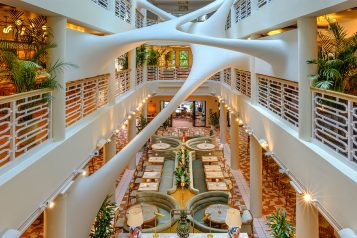The mysterious sake can be a polarizing beverage—it seems that most either love it, or…haven’t tried it (you thought I was going to say “hate it,” didn’t you?). Dating back to centuries ago in Japan, it is said that the elusive Samurais enjoyed sake as part of their training process; so, not only does it have staying power, but if it’s good enough for Samurais, it should be good enough for you. But on a serious note, it’s an incredibly elegant drink and severely underrated, so if you haven’t given it a go, I highly recommend you do. Still not convinced? That’s ok, I have reinforcements. Here, I sat down with Wine Access’ VP of Wine, Eduardo Dingler (and self-proclaimed sake enthusiast) to get a little sake 101 for those of you who haven’t stepped into the sake game, or who are new to it, like myself, and have lots to learn. In addition, Eduardo is actually a Certified Sake Professional, previously with the Global Morimoto Group for 10 years as Corporate Beverage Director, with experience at some of Napa Valley’s most iconic restaurants like Tra Vigne and Bistro Don Giovanni; he also serves as a professional Wine, Sake and Spirits Judge for several competitions, both here in the U.S. and in Japan. So, read on and get excited for this lesson in sake to prep you not just for your next Nobu or Zuma meal, but for a wide range of cuisines and dishes across the spectrum. And click here to discover some of Wine Access’ sakes available now for delivery straight to your door.

DEYVANSHI MASRANI: What is sake?
EDUARDO DINGLER: Sake is an ancient beverage that was born in Japan, made from four ingredients: rice, water, yeast and Koji. There are dozens of strains of rice most commonly used to make sake, which differ from table rice. Rice provides the main starch component and main classifications are designated by polishing or milling away the outer layers of the grains, and therefore, uncovering layers of flavor and texture. Some of the most common rice strains in sake are Yamadanishiki, Omachi and Gohyakumangoku; but, like wine grapes, there are hundreds of rice strains ranging from heirlooms to hybrids. Water styles can be split in two main types—hard and soft water—referring to the mineral content. Hard water sake has more depth and complexity while soft water sake creates a silky and delicate style.Yeast is what converts sugars into alcohol; in the case of sake it delivers a very important aromatic component depending on the strain that is used, which can be naturally occurring or a ‘designer’ strain. Finally [there’s] Koji, an element used throughout Japan to produce several staples of the Japanese lifestyle, like soy sauce, miso and Shochu (Japanese distillate). Koji is a fungus or mold that interacts with the rice starch to convert it into sugar, and for the yeast to further convert into alcohol. There’s [actually] also a fifth ingredient that may be utilized to make sake: brewers alcohol. This style is called Honjozo. As opposed to the common misconception of this being of less quality or “rocket fuel,” as some may like to joke, Honjozo generally offers an elevated experience with lifted aromas and sharp definition in the palate.
DM: What are some myths about sake that you can dispel for us—for instance, is it a drink that can only be paired with sashimi or sushi?
ED: Sake is a highly versatile beverage that delivers a number of styles, just like wine. There are sakes that are rich and powerful and make for great pairings with meat, hamburgers, Indian and Mexican foods, while other styles are delicate and seductive, best paired with sashimi and less nuanced dishes. Sake is not distilled; it is brewed more like beer. Alcohol ranges from 10-to-20 percent and in average, around 16 percent more like a glass of California red wine. It’s purity of ingredients and lack of additives make sake an excellent option, which when enjoyed in moderation, is quite healthy—and you’ll have no hangover.
DM: There are classifications of sake that can be a little intimidating and difficult to understand, if you’re not too familiar with the drink as a whole. Can you walk us through the basics of these classifications? For instance, what’s the difference between a Daiginjo and a Junmai Daiginjo?
ED: Sake classifications range, depending on the polishing of the rice, which create three main categories of premium sake. Daiginjo—being the purest or most delicate, has to be polished 50% or more, leaving less than half of the original grain. Ginjo has to be 40% or more taken away, and Junmai or Jonjozo, below that. The word ‘Junmai’ means Pure (Jun) Rice (Mai). When you see this name, it means there has not been any alcohol added. A great place to start is with Junmai Ginjo or Ginjo; this category offers a middle-ground and generally a great area to gauge your new favorite style. Also, Daiginjo level sakes are great and beautiful, but 99% of the time, they are more expensive, simply because it is more time consuming to produce, and it has lower yields. I am a huge fan of Honjozo and Junmai, which tend to be more flavorful and complex. There are other very important sake terms like Genshu, which means ‘undiluted,’ creating a more robust style; Nama means ‘unpasteurized,’ for a more lively and zippy style. Nigori, means ‘unfiltered’ or cloudy sake. Tokubetsu means ‘special,’ often a higher-polishing on the rice than stated on the label. Koshu means ‘aged,’ by law aged three years; this style delivers a Sherry-like quality with a nutty tone.
DM: If you are in a restaurant ordering sake, does higher price equate higher quality? How do you choose a sake to drink with a meal at a restaurant?
ED: Unlike other beverages like wine, sake pricing doesn’t always mean higher quality being that most of the premium sake is incredible. The difference, like in much of the Japanese culture, if there’s no labor or product involved, it doesn’t demand a higher price. Junmai or Honjozo requires less rice and production time generally, but also delivers a more complex experience, while Daiginjo is more expensive, but more floral and soft, generally. Non-Japanese restaurants like Cosme in NYC by Enrique Olvera have adopted sake in their list, arguing that it makes for a great pairing and they are not wrong. When encountered with layers of flavor and spice, a Junmai can be your best friend.
DM: Hot sake versus cold sake—what are the differences and when is it more appropriate to have one over the other?
ED: Hot sake enjoyment dates back to centuries ago; stories say that Samurais used it to heal. Unfortunately, the introduction of hot sake in the U.S. was using lower quality sake, which hurt the reputation. That being said, there are a number of ‘rustic’ styles of sake with structure and delivery that are great with some heat. One of my favorite exercises with sake is choosing an earthy Junmai like Hirai from Nilgata and trying it with three different diets at three temperatures. For instance, braised pork belly with hot sake; seared scallops with warm sake; and oysters with the cold version. It’s pure magic! As a side note, abstain from applying heat to Namasake or Daiginjo sake; it will destroy the purity and elegance of the styles.

DM: What is the ideal time to drink sake, and is there a “decanting process” or time, similar to wine?
ED: Although there is a benefit from a sake opening in the glass, which I compare to a Carlos Gardel tango, sake is ready to drink upon opening; [it] is beautiful from the get-go.
DM: What is the ideal type of glassware or cup to drink from, for sake?
ED: Ceremonially speaking, sake is served in an Ochoko: a ceramic, small cup. There are a couple of beautiful rules at the table when enjoying this vessel: you cannot pour your own and you have to constantly look after your neighbors to refill their tiny cups—simply a generous gesture for the people around you. The downside is that sake, just like wine, generally benefits from a proper glass. There’s a reason why glass producers have put a lot of time into developing the perfect options. At a restaurant or at home, I enjoy sake out of a proper wine glass.
DM: What are you favorite sakes that are available on Wine Access?
ED: Picking a favorite sake is like picking your favorite Beatles song; there’s a time and place for all! But if I have to think about the ones that I enjoy more often, I would say King of Modern Light Junmai Ginjo by Minenohakubai Shuzo in Niigata [now 22% off on Wine Access]. The first time I tasted this sake was in Niigata at Sake No Jin, the largest sake gathering in the world. When I came across this sake I was hooked by its citrus-toned notes; it reminded me of Bordeaux Blanc. It took forever to convince the producer to export to the U.S. I also love Katafune Tokubetsu Honjozo Genshu by Takeda Shuzo in Niigata [now 24% off on Wine Access]. Takeda San is not only one of my favorite people, but also, him and his small team make some of the most compelling sakes full of tension, richness and definition, and have been awarded around the globe for their efforts. Lastly, Tamura Shuzo’s Ginginga Junmai Ginjo from Tokyo [now 18% off on Wine Access]. This sake is made unlike any other, utilizing Ginginga rice from Iwate that makes a sharp and elegant style, also using four yeast strains of sake fermented separately, then blending creating an orchestra of aromas.























